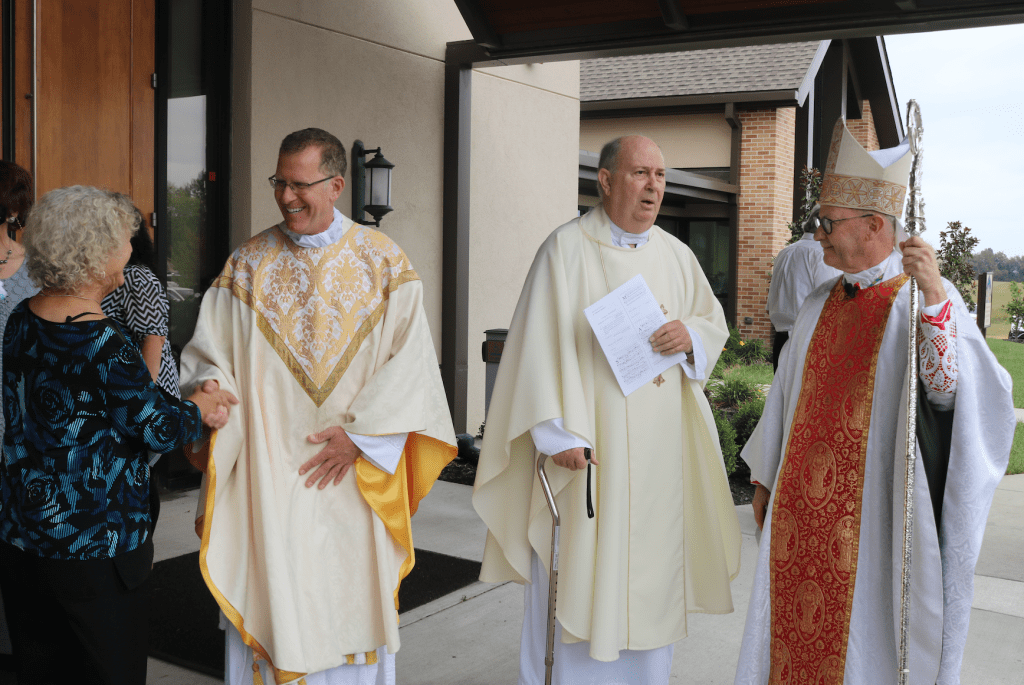
by Marc and Julie Anderson
mjanderson@theleaven.org
BASEHOR — In 13 years as a bishop, Bishop James Conley of the Diocese of Lincoln said he’d never blessed an organ.
That is until recently.
The bishop celebrated the 10:30 a.m. Mass on Oct. 3 to mark the patronal feast of Holy Angels Parish.
Concelebrating the Mass were Abbot James Albers, OSB, pastor Father McDonald, chancellor and vicar general Father John Riley, and Father Ronald Livojevich, a retired archdiocesan priest. Prior to Mass, Bishop Conley blessed the parish’s “new” organ.

Featured on the radio show called “Pipedreams,” the organ known as Opus 5 is famous throughout church music circles. Built in 1997 by Halbert Gober of Gober Organs, it is completely hand built, has 1,317 pipes and is perhaps the only one in North America people can walk through. It has no electrical parts except for that of the blower, making it similar in design and sound to organs from the 16th century.
Built for the Lutheran Church of the Good Shepherd in Brooklyn, Ohio, a suburb of Cleveland, the organ stood against the building’s back wall. When the congregation disbanded, the building was purchased by St. Elias Catholic Church; however, the church had no use for the organ. As part of the Melkite Rite, the faith community is steeped in the Byzantine tradition, relying heavily on liturgical chant.
The organ was listed for sale with the Organ Clearing House, an organization whose mission is to, among other things, “help churches, schools and private individuals acquire high-quality vintage pipe organs, preserve venerable instruments from abandonment or destruction.”

Over time, the St. Elias community grew weary of waiting for someone to buy the organ and was about ready to demolish it when Father McDonald heard about it.
First, Dr. Lucas Tappan, director of liturgy and music at Most Pure Heart of Mary Parish in Topeka, called him.
“He said, ‘Father, I’ve got to tell you this is the opportunity of a lifetime. This will be the best organ in any Catholic church in the state of Kansas. It is that good of an organ,’” Father McDonald said Tappan told him.

After talking with Dr. Tappan, Father McDonald got a call from Kevin Vogt, director of worship and sacred arts at St. Michael Parish in Leawood.
Vogt said, “Father, I know you have a love for beauty of sacred music and appreciate it, and I thought you could follow through with it.”
Father McDonald wasted no time.
“This incredible piece of artistry was going to be in a dumpster,” Father McDonald said, adding the organ valued once at $900,000 is now worth at least $1 million, if not more.
Calling an emergency finance council meeting within days, the parish was all set to buy the organ valued at the time at $900,000. Both the finance council and pastoral council had approved the purchase. Then, COVID-19 turned the world upside-down, and the parish thought it might not be prudent to expend the funds.
That’s when parishioners Terry and Donna Thomas formed the Holy Angels Music Guild to raise funds privately. Other guild members included Jacques and Sara Moraille, Tim and Diane Jones, Tim and Jeri McDonnell, Laura Beeves, Craig Gaffney and Vogt. The guild set up an account with the Greater Kansas City Foundation in the form of a 501(c)(3), and donations poured in, allowing the parish to officially purchase the instrument in September 2020.

In early November 2020, the organ arrived in Basehor. Shortly thereafter, Gober temporarily relocated from Toronto to both fit the organ to its new space and properly voice it with the goal of making it sound even better than when it was in Ohio.
Thomas agreed.
“I don’t know how else to explain it. It’s just a different type of beauty. It’s just beautiful,” Donna Thomas said, adding the sound is “just heavenly.”
“This is such a unique masterpiece of an organ. I think it’s going to expand the beauty of the worship as it should, and I think it’s going to introduce a whole new world of beauty in the form of music to the region to have this kind of organ in our midst. I’m not sure everybody understands how important saving this organ was in the organ world.”

The actual Rite of Blessing consisted of several parts. First, several members of the Little Sisters of the Lamb intoned the “Te Deum,” a hymn of praise and thanksgiving dating back to at least the fourth century. Then, the bishop read an introduction from the Book of Blessings, and Father McDonald read a passage from St. Paul’s Letter to the Colossians, which included these words: “Let the peace of the word of Christ, as in all wisdom you teach and admonish one another, singing psalms, hymns and spiritual songs with gratitude in your hearts to God.”
The rite continued with “the singing of the organ,” during which the bishop invoked the organ to sound forth as it responded to each of eight invocations beginning with, “Awake, O sacred organ! Intone the praises of God, our Creator and Father!”
The rite concluded with the playing of “Toccata Qunita” composed by Johann Speth, while the bishop incensed the organ.
When all is said and done, Thomas said she’d like others to experience the organ firsthand.
“Just come and see it. Come listen to it. Enjoy its beauty. It’s just glorious sound.”






